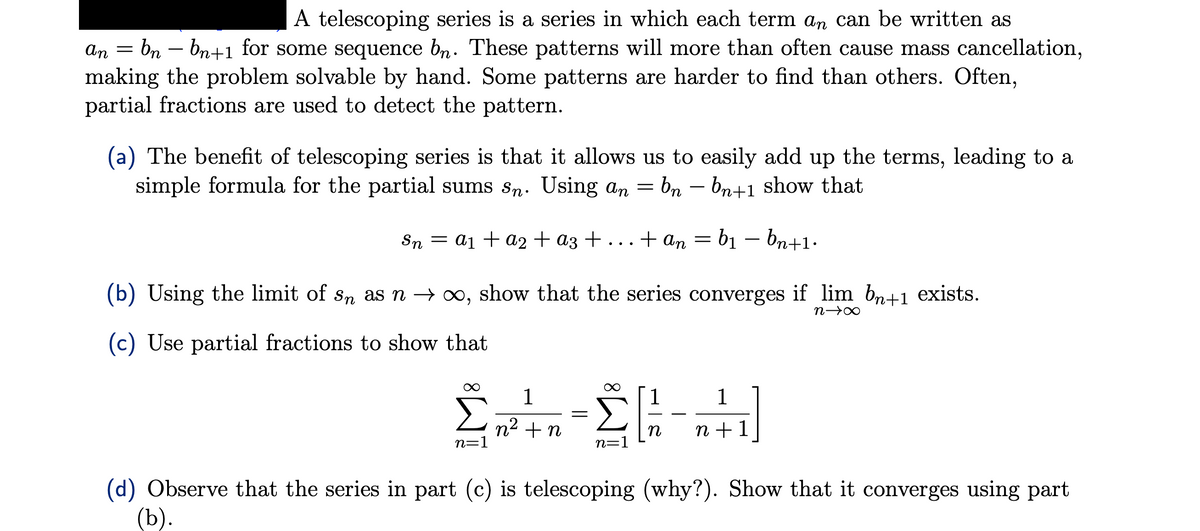A telescoping series is a series in which each term an can be written as an = bn-bn+1 for some sequence bn. These patterns will more than often cause mass cancellation, making the problem solvable by hand. Some patterns are harder to find than others. Often, partial fractions are used to detect the pattern. (a) The benefit of telescoping series is that it allows us to easily add up the terms, leading to a simple formula for the partial sums sn. Using an = bn -bn+1 show that Sn = a₁ + a2 + a3 +...+ an = b₁ bn+1. n→∞ (b) Using the limit of sn as n → ∞, show that the series converges if lim bn+1 exists. (c) Use partial fractions to show that Σ n=1 1 n² + n = ∞ n=1 1 n n+ (d) Observe that the series in part (c) is telescoping (why?). Show that it converges using part (b)
A telescoping series is a series in which each term an can be written as an = bn-bn+1 for some sequence bn. These patterns will more than often cause mass cancellation, making the problem solvable by hand. Some patterns are harder to find than others. Often, partial fractions are used to detect the pattern. (a) The benefit of telescoping series is that it allows us to easily add up the terms, leading to a simple formula for the partial sums sn. Using an = bn -bn+1 show that Sn = a₁ + a2 + a3 +...+ an = b₁ bn+1. n→∞ (b) Using the limit of sn as n → ∞, show that the series converges if lim bn+1 exists. (c) Use partial fractions to show that Σ n=1 1 n² + n = ∞ n=1 1 n n+ (d) Observe that the series in part (c) is telescoping (why?). Show that it converges using part (b)
College Algebra
7th Edition
ISBN:9781305115545
Author:James Stewart, Lothar Redlin, Saleem Watson
Publisher:James Stewart, Lothar Redlin, Saleem Watson
Chapter8: Sequences And Series
Section: Chapter Questions
Problem 6CC
Related questions
Question

Transcribed Image Text:A telescoping series is a series in which each term an can be written as
an
bn - bn+1 for some sequence bn. These patterns will more than often cause mass cancellation,
making the problem solvable by hand. Some patterns are harder to find than others. Often,
partial fractions are used to detect the pattern.
-
(a) The benefit of telescoping series is that it allows us to easily add up the terms, leading to a
simple formula for the partial sums sn. Using an = bn bn+1 show that
Sn = a₁ + a2 + a3 + ... + an = b₁ bn+1.
(b) Using the limit of sn as n → ∞, show that the series converges if lim bn+1 exists.
n→∞
(c) Use partial fractions to show that
1
1
Στις 24
n² + n
n+ 1
n=1
n=1
=
(d) Observe that the series in part (c) is telescoping (why?). Show that it converges using part
(b).
Expert Solution
This question has been solved!
Explore an expertly crafted, step-by-step solution for a thorough understanding of key concepts.
This is a popular solution!
Trending now
This is a popular solution!
Step by step
Solved in 5 steps

Recommended textbooks for you

College Algebra
Algebra
ISBN:
9781305115545
Author:
James Stewart, Lothar Redlin, Saleem Watson
Publisher:
Cengage Learning

Algebra and Trigonometry (MindTap Course List)
Algebra
ISBN:
9781305071742
Author:
James Stewart, Lothar Redlin, Saleem Watson
Publisher:
Cengage Learning

Algebra & Trigonometry with Analytic Geometry
Algebra
ISBN:
9781133382119
Author:
Swokowski
Publisher:
Cengage

College Algebra
Algebra
ISBN:
9781305115545
Author:
James Stewart, Lothar Redlin, Saleem Watson
Publisher:
Cengage Learning

Algebra and Trigonometry (MindTap Course List)
Algebra
ISBN:
9781305071742
Author:
James Stewart, Lothar Redlin, Saleem Watson
Publisher:
Cengage Learning

Algebra & Trigonometry with Analytic Geometry
Algebra
ISBN:
9781133382119
Author:
Swokowski
Publisher:
Cengage



Glencoe Algebra 1, Student Edition, 9780079039897…
Algebra
ISBN:
9780079039897
Author:
Carter
Publisher:
McGraw Hill